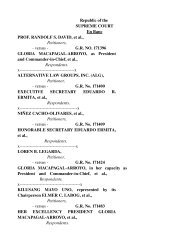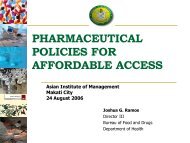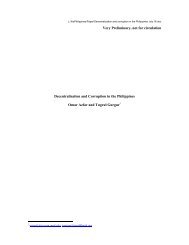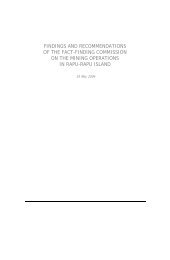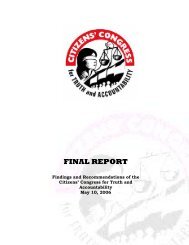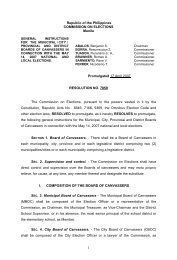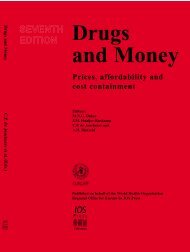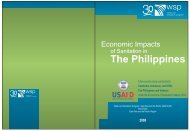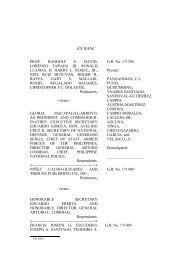The state of water resources in the Philippines - Greenpeace
The state of water resources in the Philippines - Greenpeace
The state of water resources in the Philippines - Greenpeace
You also want an ePaper? Increase the reach of your titles
YUMPU automatically turns print PDFs into web optimized ePapers that Google loves.
In March 2007, <strong>the</strong> DENR warned <strong>of</strong> ground<strong>water</strong> contam<strong>in</strong>ation <strong>in</strong> Pamplona,<br />
Las Piñas. Tricholoroethylene (TCE), a carc<strong>in</strong>ogen, was found <strong>in</strong> 19 out <strong>of</strong> 102<br />
wells tested <strong>in</strong> <strong>the</strong> vic<strong>in</strong>ity <strong>of</strong> a Philips Corporation facility. <strong>The</strong> <strong>water</strong> was<br />
rendered unfit for human consumption (GMANews.TV, 21 March 2007).<br />
Official documentation <strong>of</strong> <strong>water</strong> pollution shows that <strong>the</strong> major pollutants,<br />
<strong>in</strong>clud<strong>in</strong>g BOD, DO, coliform, nitrates, and suspended solids, have <strong>in</strong>creased<br />
steadily <strong>in</strong> Philipp<strong>in</strong>e rivers. It was observed, however, that <strong>of</strong>ficial Philipp<strong>in</strong>e<br />
data tend to emphasize BOD and o<strong>the</strong>r biological pollutants to <strong>the</strong> exclusion <strong>of</strong><br />
o<strong>the</strong>r—more <strong>in</strong>dustrial and more toxic—pollutants, hence, do not clearly identify<br />
concrete impacts <strong>of</strong> <strong>the</strong>se more hazardous wastes on health and <strong>the</strong><br />
environment.<br />
Toxic <strong>in</strong>cidences and impacts <strong>of</strong> polluted <strong>water</strong> bodies only come to public<br />
attention when a relatively huge number <strong>of</strong> <strong>the</strong> population is <strong>in</strong>volved and if <strong>the</strong><br />
effects on health are graphic and immediate.<br />
In 2007, a broad study was carried out by <strong>Greenpeace</strong> to <strong>in</strong>vestigate <strong>the</strong> quality<br />
<strong>of</strong> various surface and ground <strong>water</strong> systems <strong>in</strong> four countries, <strong>in</strong>clud<strong>in</strong>g <strong>the</strong><br />
Philipp<strong>in</strong>es. Water from <strong>the</strong> systems <strong>in</strong>vestigated is known to be abstracted for<br />
distribution as dr<strong>in</strong>k<strong>in</strong>g <strong>water</strong>, generally follow<strong>in</strong>g purification treatments that<br />
<strong>in</strong>clude chlor<strong>in</strong>ation. Treated <strong>water</strong>s are supplied ei<strong>the</strong>r via piped distribution<br />
networks or as bottled <strong>water</strong>. However, many <strong>of</strong> <strong>the</strong>se river and canal systems<br />
also receive <strong>in</strong>puts <strong>of</strong> potentially contam<strong>in</strong>ated waste<strong>water</strong>s ei<strong>the</strong>r from po<strong>in</strong>t<br />
sources and/or diffuse run-<strong>of</strong>f from agricultural land. <strong>The</strong>se and o<strong>the</strong>r sources<br />
may also be contribut<strong>in</strong>g to contam<strong>in</strong>ation <strong>of</strong> ground<strong>water</strong> aquifers <strong>in</strong> <strong>the</strong>ir<br />
vic<strong>in</strong>ity, some <strong>of</strong> which are used untreated as dr<strong>in</strong>k<strong>in</strong>g <strong>water</strong>. (See Annex 1)<br />
In ano<strong>the</strong>r <strong>Greenpeace</strong> report released <strong>in</strong> February 2007, <strong>water</strong> samples taken<br />
from <strong>in</strong>dustrial e<strong>state</strong>s <strong>in</strong> <strong>the</strong> Philipp<strong>in</strong>es were studied. <strong>The</strong> results showed<br />
vary<strong>in</strong>g degrees <strong>of</strong> contam<strong>in</strong>ation from different hazardous chemicals, <strong>in</strong>clud<strong>in</strong>g<br />
volatile organic compounds (VOCs) and heavy metals. VOCs are known to affect<br />
<strong>the</strong> kidneys, <strong>the</strong> central nervous system and <strong>the</strong> liver, and are potentially<br />
carc<strong>in</strong>ogenic. All sites notably conta<strong>in</strong>ed chlor<strong>in</strong>ated VOCs, toxic solvents or<br />
degreasers used <strong>in</strong> “clean<strong>in</strong>g” semiconductors and o<strong>the</strong>r electrical equipment.<br />
Water samples taken from <strong>the</strong> Cavite Export Process<strong>in</strong>g Zone (CEPZA) <strong>in</strong><br />
Rosario, Cavite, <strong>in</strong> particular, conta<strong>in</strong>ed tetrachloroe<strong>the</strong>ne at n<strong>in</strong>e times above<br />
<strong>the</strong> WHO guidance values for exposure limits, and 70 times <strong>the</strong> US<br />
Environmental Protection Agency maximum contam<strong>in</strong>ant level for dr<strong>in</strong>k<strong>in</strong>g <strong>water</strong>.<br />
Elevated levels <strong>of</strong> metals, particularly copper, nickel and z<strong>in</strong>c, were also found <strong>in</strong><br />
ground<strong>water</strong> samples <strong>in</strong> o<strong>the</strong>r sites, also with<strong>in</strong> <strong>the</strong> prov<strong>in</strong>ce (Cutt<strong>in</strong>g Edge<br />
Contam<strong>in</strong>ation: A Study <strong>of</strong> Environmental Pollution dur<strong>in</strong>g <strong>the</strong> manufacture <strong>of</strong><br />
Electronic Products, 2007). As yet, no health cases have been directly l<strong>in</strong>ked to<br />
<strong>the</strong> contam<strong>in</strong>ation. (See also Annex 2).<br />
However, <strong>The</strong> World Health Organization (WHO) and <strong>the</strong> United Nation’s<br />
Children’s Fund (UNICEF) <strong>in</strong> <strong>the</strong>ir publication “Promot<strong>in</strong>g and Protect<strong>in</strong>g Human<br />
Health”, <strong>state</strong>s that “(…) Anthropogenic chemical pollution <strong>of</strong> surface <strong>water</strong>s,<br />
ma<strong>in</strong>ly by <strong>in</strong>dustry and agricultural run<strong>of</strong>f, is a health hazard, but <strong>the</strong> impacts on<br />
GREENPEACE | <strong>The</strong> <strong>state</strong> <strong>of</strong> <strong>water</strong> <strong>in</strong> <strong>the</strong> Philipp<strong>in</strong>es 24




